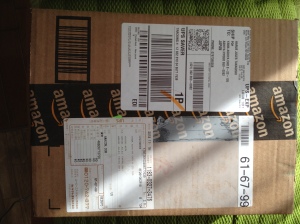FINALLY!!!
On 4 December, an amazon market place seller shipped a magazine to me (using USPS airmail). The anticipated delivery time was between 25 and 32 days.
Last week, I wrote to them asked them to track the item as the only tracking information I got on the amazon.com site was that the item had been “received at the facility in Texas” on 4 December.
As it was day 45 since shipment, the seller decided it was best to give me a full refund because the magazine was no longer available for re-shipping.
Today, on day 49, I received the shipment.
I have to say that the customer service representative was right when she wrote, “you will receive the magazine one day.”
I asked her if she wanted to know if and when I ever get the item, and she responded in something that read like “don’t bother, keep the money, go away.” I suspect this happens often because on amazon market place and eBay, merchants are evaluated by the consumers on responsiveness to inquiries, and whether the items were received in the promised time.
Of course, the customer service rep was quick to point out that the delay is not their fault. And as an industry insider, I was happy to accept that. Still…
The magazine was US$8.00. I was charged $12.80 for shipping.
While I believe the yardstick or rule of thumb is that most consumers would accept around 10% of the value of the goods as shipping charge, I opted to pay more for shipping than I did for the publication because it was something I could not get in Japan. When the refund was issued, I got the entire sum back.
The ironic thing is that when I ordered two books, worth $55, from a different merchant on amazon market place, I received it in 5 days and via UPS Saver, and the shipping charge was only $6.88.
I told the CS rep that, and suggested that they look into getting UPS Saver instead of using USPS, and she said,
“UPS is too expensive for yarn and books.” (But I just told her that it is actually CHEAPER!)
There are a couple of things to learn from this:
1) UPS has a ways to go to get merchants to understand that they have a competitive shipping option as their image as an express courier is that they are too expensive for people who ship bulky but light stuff where volumetric pricing makes it prohibitive;
2) USPS needs to get their act together – their slower-than-molasses-in-winter delivery lead times are costing their customers business. In this case, it is obvious that the merchant was penalized for using USPS. Had they used UPS Saver, they would have had a happy customer (me) and kept their money. Now, they lost the customer and the entire taking for the transaction.
And it was “first class mail” – whatever that means in the US these days.
I know it was peak season, but when I sent something to the US via first class mail through Japan Post (an item I returned to amazon.com), I know it took under a week to be delivered as I got my refund in that space of time.
So why does it take 49 days when the item originates from the US? Where do they keep all the “first class mail” for over 45 days?
I am assuming that the delay is within USPS because once an item is handed over to the airline, it takes under 20 hours to get to a mail center in Japan. And Japan Post sorts and delivers within 2 business days. Customs may hold an item for inspection, but books usually come through quickly. So, if one assumes that the airline and Japan Post take a maximum of 5 days, the item was somewhere within USPS for 44 of the 49 days it took to get here…
